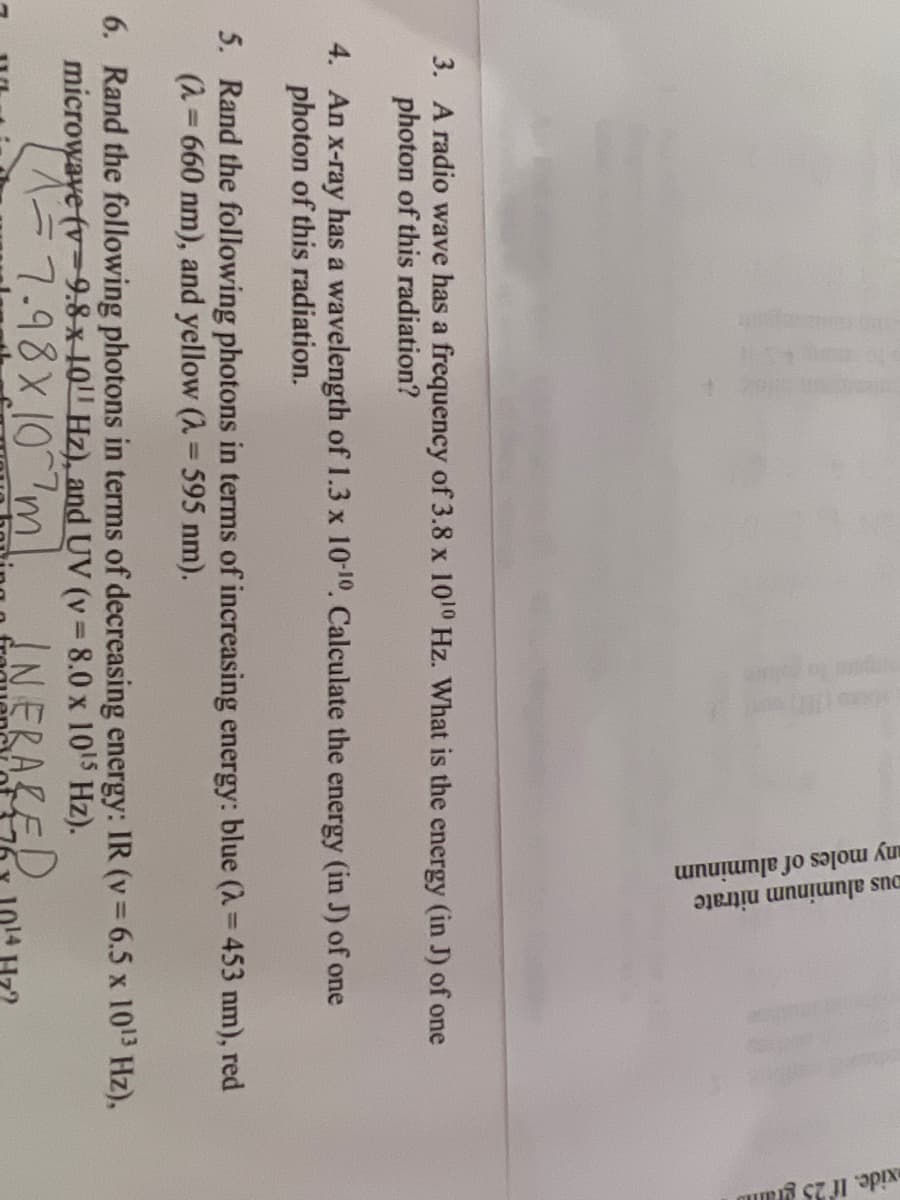3. A radio wave has a frequency of 3.8 x 1010 Hz. What is the energy photon of this radiation? 4. An x-ray has a wavelength of 1.3 x 10-10. Calculate the energy (in photon of this radiation. 5. Rand the following photons in terms of increasing energy: blue ( (2= 660 nm), and yellow (2=595 nm).
3. A radio wave has a frequency of 3.8 x 1010 Hz. What is the energy photon of this radiation? 4. An x-ray has a wavelength of 1.3 x 10-10. Calculate the energy (in photon of this radiation. 5. Rand the following photons in terms of increasing energy: blue ( (2= 660 nm), and yellow (2=595 nm).
Chemistry: The Molecular Science
5th Edition
ISBN:9781285199047
Author:John W. Moore, Conrad L. Stanitski
Publisher:John W. Moore, Conrad L. Stanitski
Chapter5: Electron Configurations And The Periodic Table
Section: Chapter Questions
Problem 5.ACP
Related questions
Question
Hi sorry to bother I know that you guys can only answer 3 questions per the ask questions so I was wondering if you could solve the following 3 for me please thank you

Transcribed Image Text:any moles of aluminum
ous aluminum nitrate
xide. If 25 gram
3. A radio wave has a frequency of 3.8 x 1010 Hz. What is the energy (in J) of one
photon of this radiation?
4. An x-ray has a wavelength of 1.3 x 10-10. Calculate the energy (in J) of one
photon of this radiation.
5. Rand the following photons in terms of increasing energy: blue (λ = 453 nm), red
(2= 660 nm), and yellow (λ = 595 nm).
6. Rand the following photons in terms of decreasing energy: IR (v = 6.5 x 10¹³ Hz),
microwave (v 9.8 x 10 Hz), and UV (v=8.0 x 10¹5 Hz).
1 = 7.98x107ml
INERALED
Expert Solution
This question has been solved!
Explore an expertly crafted, step-by-step solution for a thorough understanding of key concepts.
This is a popular solution!
Trending now
This is a popular solution!
Step by step
Solved in 2 steps with 2 images

Knowledge Booster
Learn more about
Need a deep-dive on the concept behind this application? Look no further. Learn more about this topic, chemistry and related others by exploring similar questions and additional content below.Recommended textbooks for you

Chemistry: The Molecular Science
Chemistry
ISBN:
9781285199047
Author:
John W. Moore, Conrad L. Stanitski
Publisher:
Cengage Learning

Chemistry: Principles and Practice
Chemistry
ISBN:
9780534420123
Author:
Daniel L. Reger, Scott R. Goode, David W. Ball, Edward Mercer
Publisher:
Cengage Learning

Chemistry & Chemical Reactivity
Chemistry
ISBN:
9781133949640
Author:
John C. Kotz, Paul M. Treichel, John Townsend, David Treichel
Publisher:
Cengage Learning

Chemistry: The Molecular Science
Chemistry
ISBN:
9781285199047
Author:
John W. Moore, Conrad L. Stanitski
Publisher:
Cengage Learning

Chemistry: Principles and Practice
Chemistry
ISBN:
9780534420123
Author:
Daniel L. Reger, Scott R. Goode, David W. Ball, Edward Mercer
Publisher:
Cengage Learning

Chemistry & Chemical Reactivity
Chemistry
ISBN:
9781133949640
Author:
John C. Kotz, Paul M. Treichel, John Townsend, David Treichel
Publisher:
Cengage Learning

Chemistry & Chemical Reactivity
Chemistry
ISBN:
9781337399074
Author:
John C. Kotz, Paul M. Treichel, John Townsend, David Treichel
Publisher:
Cengage Learning

Chemistry: An Atoms First Approach
Chemistry
ISBN:
9781305079243
Author:
Steven S. Zumdahl, Susan A. Zumdahl
Publisher:
Cengage Learning

General Chemistry - Standalone book (MindTap Cour…
Chemistry
ISBN:
9781305580343
Author:
Steven D. Gammon, Ebbing, Darrell Ebbing, Steven D., Darrell; Gammon, Darrell Ebbing; Steven D. Gammon, Darrell D.; Gammon, Ebbing; Steven D. Gammon; Darrell
Publisher:
Cengage Learning